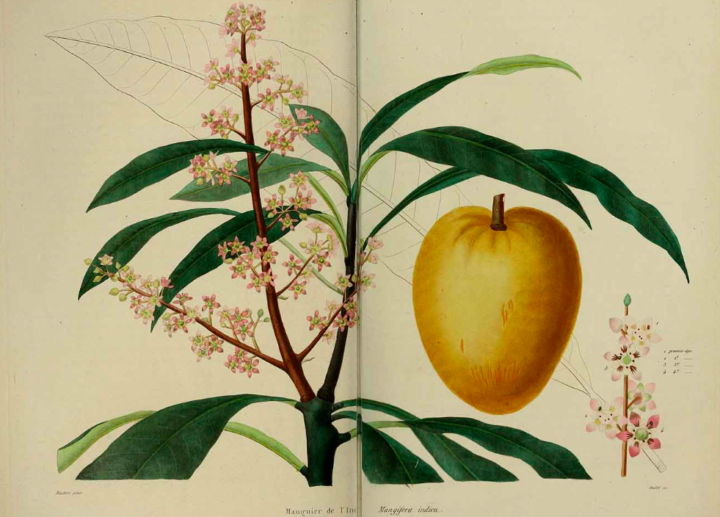CULTURAL SIGNIFICANCE IN ANCIENT CIVILIZATIONS
A well-known myth from Hindu mythology features Lord Ganesha and his brother Kartikeya, who are offered a mango by their parents, Shiva and Parvati. While Kartikeya sets off on a race around the world to earn it, Ganesha simply circles his parents, declaring them his universe. He’s rewarded with the fruit—a tale of love, devotion, and, interestingly, the spiritual weight of the mango.
In Buddhism, the mango tree becomes a symbol of reflection and serenity. The courtesan Amrapali gifted Buddha a mango grove, which he used for meditation.
Chinese monks such as Faxian and Song Yun documented these groves, revealing how the mango became part of Buddhist spiritual geography.

THE MUGHAL INFLUENCE AND ROYAL PATRONAGE
Few empires shaped the mango’s legacy like the Mughals, whose 16th–18th century reign marked a golden age for its cultivation in India.
It began with Babur, who fell in love with mangoes after tasting them post-Panipat. Even in exile, his son Humayun received mangoes via Babur’s courier network.
Akbar the Great, passionate about agriculture, established the Lakhi Bagh orchard near Darbhanga, planting over 100,000 trees and pioneering systematic grafting. He curated famed varieties like Totapuri, Rataul, and Kesar.
Shah Jahan reportedly punished Aurangzeb for hoarding mangoes and favored Dara Shikoh, his horticulturist heir, who authored Nuskha Dar Fanni Falahat, detailing mango grafting. Even diplomacy ripened with mangoes—Aurangzeb sent them to Shah Abbas of Persia to win favour.

GLOBAL SPREAD AND COLONIAL INFLUENCE
While Asia had long embraced the mango, its global spread began in the colonial era, led by the Portuguese and Spanish in the 16th century.
The Portuguese introduced mangoes from Goa to Africa and then Brazil in the early 1700s, planting them in Mozambique, Guinea, and other coastal regions.
By the late 18th century, mangoes reached the Caribbean, Barbados, and Jamaica. They arrived in Hawaii by 1809 and Florida in the 1830s, aided by American botanists. Between 1899 and 1937, the U.S. Department of Agriculture introduced over 500 varieties from India, the Philippines, and the West Indies.
By the late 19th century, mangoes had reached Australia, Fiji, and South Africa. Today, while India remains the top producer, countries like Mexico, Thailand, Indonesia, and Brazil have built their own mango legacies.
LITERARY AND ARTISTIC LEGACY
Mangoes didn’t just enter kitchens—they infused literature, art, and folklore. In 4th-century Meghaduta, Kalidasa set scenes of longing amid mango groves. The Panchatantra wove them into moral tales, while Persian poets used mangoes as metaphors for desire and elegance.
Babur lamented the lack of good mangoes in Central Asia, and Ghalib quipped that only fools disliked them. Tagore celebrated their blossoms in poems like Aamer Majori. Artistically, they appear in Mughal miniatures, temple carvings at Khajuraho and Sanchi, and paintings from the Pahari and Kangra schools. Their curving shape even inspired the paisley—an enduring Indian symbol of good fortune.
The curving shape of the mango even inspired the famous paisley design, now an iconic Indian motif symbolizing good fortune. In modern literature, mangoes symbolize identity in Rushdie’s Midnight’s Children and lost innocence in Roy’s The God of Small Things.

NUTRITION AND MEDICINAL USES
Also known as the Mangifera indica, mango offers more than just flavour—it’s packed with nutrients and therapeutic compounds.
The fruit contains vitamins A, C, E, and B6, along with flavonoids, carotenoids, dietary fiber, and minerals like potassium and copper. These compounds may promote immune function, skin health, and heart health.
Traditional medicine has long used mango leaves, bark, and flowers for treating ailments. Recent studies show that mango leaf extract may help regulate blood sugar and improve insulin sensitivity—making it useful for managing type 2 diabetes.
Mangiferin, an antoxidiant present in mango, has been studied for its anti-inflammatory, anti-obesity, and antimicrobial effects. In short, mangoes are as medicinal as they are mouth-watering.
REFERENCES
Shah, N.C., 2017. Mango in Ancient Indian Sculptures and during Akbar Period. Indian Journal of History of Science, 52(13), pp.335-338.
Yadav, D. and Singh, S.P., 2017. Mango: History origin and distribution. Journal of Pharmacognosy and Phytochemistry, 6(6), pp.1257-1262.
Swaroop, A., Bagchi, M., Moriyama, H. and Bagchi, D., 2018. Health benefits of mango (Mangifera indica L.) and mangiferin. Jpn J Med, 1(2), pp.149-154.

Leave a Reply